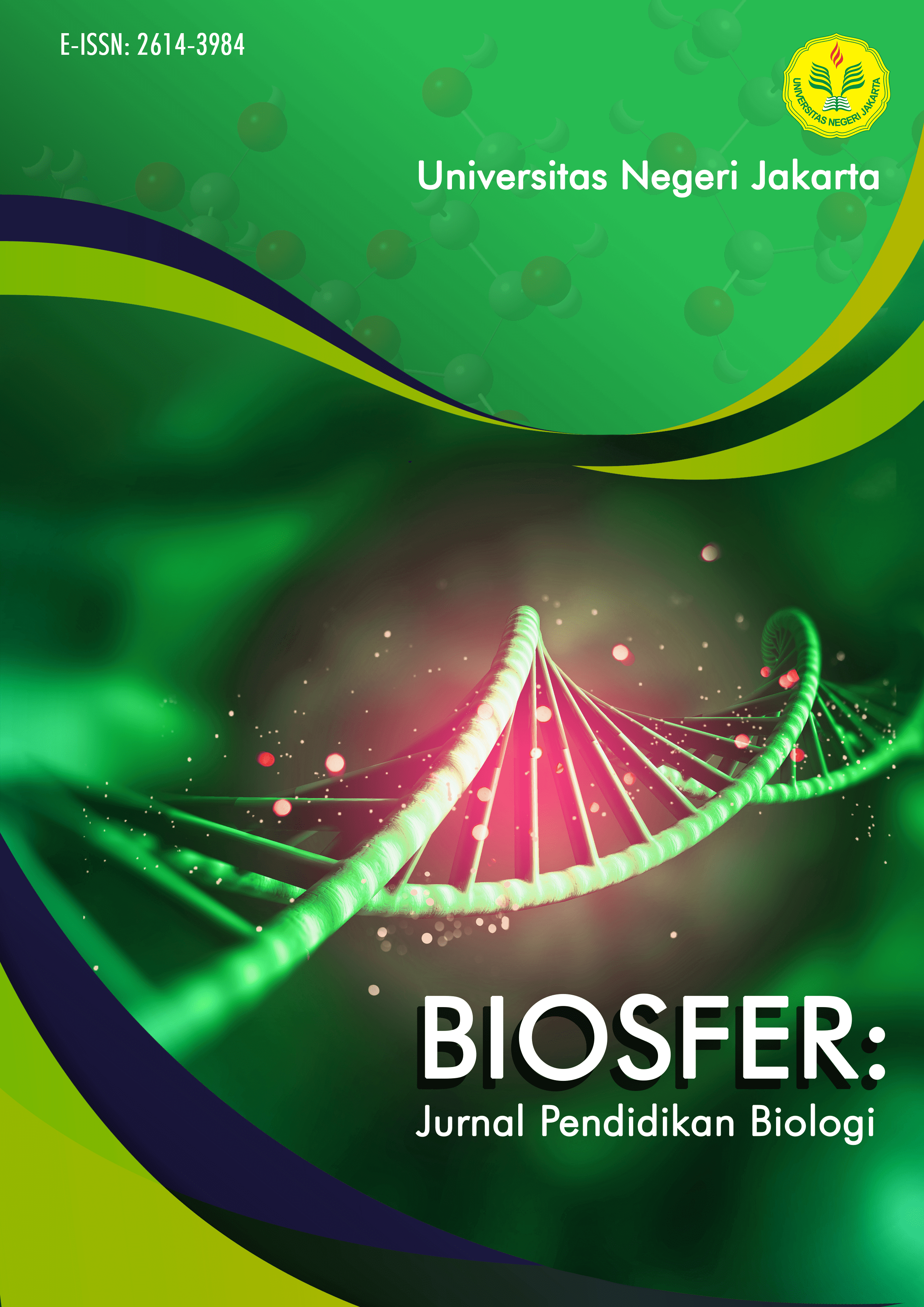Augmented reality (AR) technology on the android operating system in human respiratory system: From organ to cell
DOI:
https://doi.org/10.21009/biosferjpb.23448Keywords:
Augmented Reality, Biology Education, Human Respiratory SystemAbstract
Understanding the object of learning material that is abstract is currently still an obstacle faced by students. The use of technology in learning is expected to reduce the obstacles faced by these students. Augmented reality (AR) is a technology that is currently being widely applied in the learning process because it is considered capable of helping students understand abstract learning materials with 3D object features. This study aims to design and develop AR, especially in the anatomical structure of organs in the human respiratory system, which is then integrated into biological practice in the laboratory. The AR application has been designed, created, validated, and published under AR Synapse (Augmented Reality Respiratory System). The AR application developed is based on the android system and has gone through validation tests by experts. Five expert validators who work as lecturers and high school teachers. Expert validation results with an average score of 3.6 from a maximum score of 4.0, which states that the AR Sinaps application is 91.2%, has functioned well, supports learning, provides objects relevant to teaching materials, and is considered to increase students' learning motivation. Furthermore, it has good prospects for continuous development. Students' satisfaction survey and user evaluation also gave a good response with an average rating percentage of 85.1%.
References
Akçayır, M., Akçayır, G., Pektaş, H. M., & Ocak, M. A. (2016). Augmented reality in science laboratories: The effects of augmented reality on university students’ laboratory skills and attitudes toward science laboratories. Computers in Human Behavior, 57, 334–342. https://doi.org/https://doi.org/10.1016/j.chb.2015.12.054
Akpınar, E. (2006). Computer Assisted Instruction in Constructing of Abstract Concepts in Science Teaching: The Unit Electricity in Our Life. Dokuz Eylül University.
Azuma, R. T. (1999). The challenge of making augmented reality work outdoors. The 1st International Symposium on Mixed Reality (ISMR99). Retrieved from https://ronaldazuma.com/papers/ismr99.pdf
Bajura, M., Fuchs, H., & Ohbuchi, R. (1992). Merging Virtual Objects with the Real World: Seeing Ultrasound Imagery Within the Patient. Proceedings of SIGGRAPH ’92, 203–210. https://doi.org/https://doi.org/10.1145/142920.134061
Bennett, N., Borg, W. R., & Gall, M. D. (1984). Educational Research: An Introduction. British Journal of Educational Studies, Vol. 32, p. 274. https://doi.org/10.2307/3121583
Celik, C., Guven, G., & Cakir, N. K. (2020). Integration of mobile augmented reality (Mar) applications into biology laboratory: Anatomic structure of the heart. Research in Learning Technology, 28(1063519), 1–11. https://doi.org/10.25304/rlt.v28.2355
Chen, C. M., & Tsai, Y. N. (2012). Interactive augmented reality system for enhancing library instruction in elementary schools. Computers & Education, 59(2), 638–652.
Chiang, T. H. ., Yang, S. J. ., & Hwang, G.-J. (2014). An Augmented Reality-based Mobile Learning System to Improve Students’ Learning Achievements and Motivations in Natural Science Inquiry Activities. Journal of Educational Technology & Society, 17(4), 352–365. Retrieved from https://www.jstor.org/stable/jeductechsoci.17.4.352
Doğan, B. & Ay, T. (2013). Biyolojinin toplum bilim ve teknoloji açısından önemi’, in Biyolojide Özel Konular, (3rd edn). https://doi.org/10.14527/9786053189596.01
Günüç, S. (2017). Eğitimde Teknoloji Entegrasyonunun Kuramsal Temelleri,. Ankara: Anı Yayıncılık.
Hurst, W. (2020). VISUAL 2019 The Fourth International Conference on Applications and Systems of Visual.
Johnson, L., et al. (2015). NMC Horizon Report: 2015 Higher Education Edition. The New Media Consortium. Austin.
Kaufmann, H. (2003). Collaborative Augmented Reality in Education. Learning, (March 2003), 1–16. https://ieeexplore.ieee.org/document/6821833
Kaya, S., Elgün, A., Üniversitesi, K., Fakültesi, E., Bölümü, İ., & Öğretmenliği, S. (2015). EĞİTSEL OyunlarİleDesteklenmi̇ş Fen the Influence of Instructional Games in Science Teaching on Primary Students ’. (1), 329–342.
Khairunnisa, S., & Aziz, T. A. (2021). Studi Literatur: Digitalisasi Dunia Pendidikan dengan Menggunakan Teknologi Augmented Reality pada Pembelajaran Matematika. Jurnal Riset Pendidikan Matematika Jakarta, 3(2), 53–62. https://doi.org/10.21009/jrpmj.v3i2.20106
Kılıç, D., & Sağlam, N. (2004). The effect of the concept maps on achievement and retention of learning in biology education’,. Hacettepe University Journal of Education, 27, 155–164.
Lee, K. (2012). Augmented Reality in Education and Training. TechTrends, 56(2), 13–21. https://doi.org/10.1007/s11528-012-0559-3
Lu, S., & Liu, Y.-C. (2015). Integrating augmented reality technology to enhance children’s learning in marine Education. Environmental Education Research, 21(4), 525–541. https://doi.org/10.1080/13504622.2014.911247 CrossMark LogoCrossMark
Mayer, R. E. (2009). Multimedia learning. https://doi.org/https://doi.org/10.1017/CBO9780511811678
Muñoz-Cristóbal, J. A., Jorrín-Abellan, I. M., Asensio-Peréz, J. I., Martínez-Monés, A., Prieto, L. P., & Dimitriadis, Y. (2015). Supporting teacher orchestration in ubiquitous learning environments: A study in primary education. IEEE Transactions on Learning Technologies, 8(1), 83–97. https://doi.org/10.1109/TLT.2014.2370634
Nechypurenko, P. P., Starova, T. V., Selivanova, T. V., Tomilina, A. O., & Uchitel, A. D. (2018). Use of augmented reality in chemistry education. CEUR Workshop Proceedings, 2257, 15–23. https://doi.org/10.31812/pedag.v51i0.3650
O’Shea, P. M. (2011). Augmented reality in Education: Current trends. International Journal of Gaming and Computer-Mediated Simulations, 3(1), 91–93. https://doi.org/10.4018/jgcms.2011010108
Qarnain, M. D. (2020). Pengembangan Aplikasi Ar-Senses Berbasis Augmented Reality Untuk Meningkatkan Penguasaan Konsep Sistem Indra Manusia Kelas …. Retrieved from http://repository.unj.ac.id/11691/
Squire, K. D., & Jan, M. (2007). Mad city mystery: Developing scientific argumentation skills with a place-based augmented reality game on handheld computers. Journal of Science Education and Technology, 16(1), 5–29. https://doi.org/10.1007/s10956-006-9037-z
Thomas, B. H. (2007). Emerging Technologies of Augmented Reality. In Emerging Technologies of Augmented Reality: Interfaces and Design. Retrieved from http://www.scopus.com/inward/record.url?eid=2-s2.0-84901571644&partnerID=tZOtx3y1
Weng, N., Bee, O., Yew, L., & Hsia, T. (2017). An Augmented Reality System for Biology Science Education in Malaysia. International Journal of Innovative Computing, 6(2), 8–13. https://ijic.utm.my/index.php/ijic/article/view/128
Wu, H. K., Lee, S. W. Y., Chang, H. Y., & Liang, J. C. (2013). Current status, opportunities and challenges of augmented reality in Education. Computers and Education, 62, 41–49. https://doi.org/10.1016/j.compedu.2012.10.024
Zulfiani, Susanti, B. H., & Qumillaila. (2017). Pengembangan Augmented Reality Versi Android Developing Android Augmented Reality As a Learning Media of. Jurnal Cakrawala Pendidikan, 36(1), 57–69.
Downloads
Published
How to Cite
Issue
Section
License
The Authors submitting a manuscript do so on the understanding that if accepted for publication, copyright of the article shall be assigned to Biosfer: Jurnal Pendidikan Biologi (Biosferjpb) and Departement of Biology Education, Universitas Negeri Jakarta as publisher of the journal.



